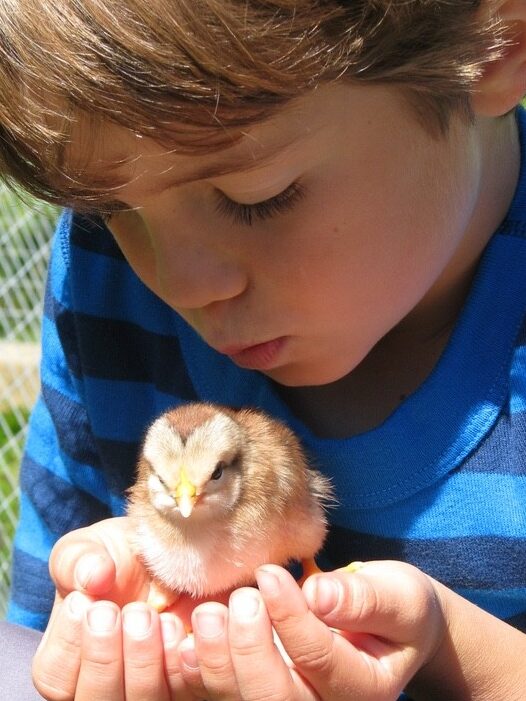Some of our first pets were baby chicks — twenty-day-old precious Buff Orpingtons, Australorps, and Rhode Island Reds. New to chicken farming, my husband and I learned how to care for them alongside our children. I could tell on that first day, however, that one of those chicks was not like the others. It was wet and looked very cold. I kept that thought to myself as my daughter lovingly fed and tended to every chick’s well-being.
Within a day that little chick had a pasty bum — and just like any mother, my daughter lovingly wiped that pasty bum every time she saw it. By this time, even she could see that this chick was not thriving. She named it Nutrition and called it Trisher because, to her 7-year-old mind, that chick needed more nurturing nutrition. It would get bumped away from the feeding trough and bumped away from the warm red light that it so badly needed. My daughter would cry as she worried about this little baby she was playing mother hen to.
By day three, I didn’t think that chick was going to make it. It ached a hole in my mama heart, wanting to protect my children from the harsh realities of farming, and of life. I wiped that pasty butt many times myself and brought the chick to the feed tray, bumping some of the others out of the way.
Not surprisingly, Trisher died on the third night. The children were asleep. Everything in me wanted to avoid telling them. When they asked, I thought, I’ll tell them the chick “went away in the night.”
Fortunately for me, and for my kids, they were too smart for euphemisms and it wouldn’t pass muster. Fortunately for me — and for my kids — my own mother had given me the gift of my tears and I know just how valuable and precious they are. Still, it was hard, three days into pets and farming and so much chick-love that their hearts were overflowing.
When my daughter learned of what even she was expecting but had tried desperately to avoid and deny, she cried. She cried hard. She cried long. She wailed. It lasted for days and seemed never to end. Again, everything in me wanted to take her pain away; wanted to pretend it wasn’t real or true.
Yet I knew the tears were not going to last forever and the sadness needed to be felt. I also knew we needed to give this chick a proper goodbye. So we did what most parents do intuitively — we had a burial ceremony. We made a cross. We dug a hole. We talked about Trisher and the precious little life this chick lived. I think all four of us cried. We were all becoming hobby farmers and we were also all building our resilience.
Sometime in that first year we lost another chicken to an eagle. There were lots more tears then. After a couple of hearty cries, my daughter said, “I’m sad but It’s easier the second time.”
And that’s exactly the point. It is not our pets’ primary purpose in life to build our resilience, but they sure do a good job of it! Keeping the heart soft enough to feel sadness and loss, such tender emotions, prepares children for the bigger losses they will face in life.
We didn’t lose any more chicks. All of them grew up to be roosters or layers and had wonderful names like Noodle, Startino, and Justice da Gorgeous. One of the roosters started attacking my four year old son from behind — an alpha thing, but that’s another story. My son wasn’t so sad when we gave that rooster away.
But when his Betta fish,”Monk Monk,” died, he cried lots. Later, when his beloved Budgie Rio died, his tears were followed by lovingly putting him in a box, laying out his wings gently, and taking pictures of his dead beautiful body.
There were many more disappointments, stressful experiences, and losses – not being invited to a birthday party, not being chosen for a lead part in the play, not sinking that buzzer shot in the basketball game, a teacher who wasn’t kind or caring. These are all opportunities to invite our children to feel vulnerably – yet so often we are caught up in our desire to make everything alright and so instead we try to cheer them up: “They like you, they just couldn’t invite everyone to their party; you should’ve got that part in the play, that was poor casting; you’re a great player, it was just bad luck; they’re a bad teacher.” Though it’s a natural instinct to make things work for our kids, it helps them build resilience for future losses when we simply invite the tears about all that’s not working for them. And that’s why Trisher’s and Rio’s deaths were important building blocks of resilience for my kids.
Years later, when grandma’s death was imminent — something my daughter particularly had anticipated and feared — she wrote her a love letter. “Dear Grams, where to begin? You are, without question, one of the most inspiring, influential, and wonderful people I have ever been blessed enough to know. It breaks my heart to think I might never again talk with you, learn to make your famous meatballs, watch Mrs Doubtfire and laugh our heads off.…” She could, even if briefly, look death straight in the eye, and convey her love. The letter goes on, written with tears in her heart, but with some confidence she could survive this inevitable loss – just as she had survived Trisher’s death.
Grandma died shortly after receiving the letter. There were many more tears to come, and they still surprise us every now and then, but we all survived with soft hearts intact. Nature has equipped us to handle stressful experiences and, if we can align with our body’s innate wisdom, we will have robust nervous systems.
There are still many more stresses and challenges to come for my kids, because it is a part of being human. I’m confident, however, that they have the template inside of them, as we all do, and the felt experience of surviving small stressors that will guide them for the rest of their lives.
______________________________________________
Editor’s note: Heather Ferguson discusses the themes of stress, trauma, and recovery with Dr. Neufeld in his new course on resilience. Self-Paced Study registration is now open. Find out more and register HERE.

